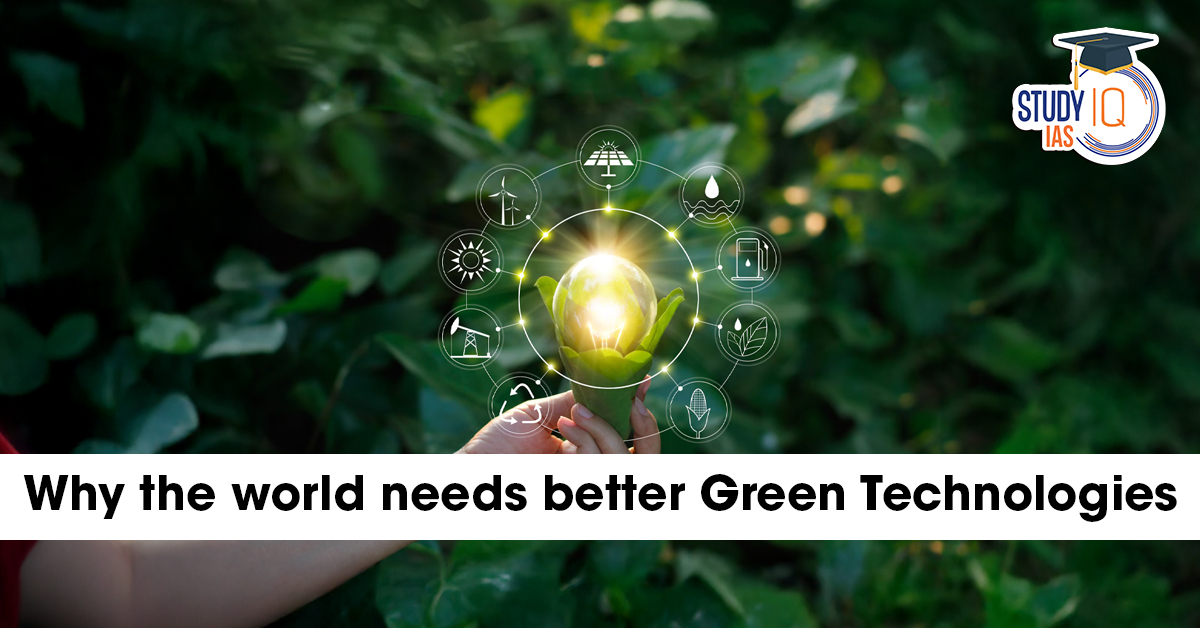Table of Contents
Context: India’s renewable energy push faces efficiency, land, and storage challenges; next-gen technologies and policy innovation are vital for sustainable growth.
Current Renewable Energy Sources in India
As of 2025, India’s installed renewable energy capacity (excluding large hydropower) stands at over 180 GW. The key sources include:
- Solar Energy
- Largest contributor among renewables (~80 GW installed).
- Rooftop solar and utility-scale solar parks (e.g., Bhadla Solar Park in Rajasthan).
- Wind Energy
- ~45 GW installed.
- Primarily concentrated in Tamil Nadu, Gujarat, Maharashtra, and Karnataka.
- Small Hydro Power (SHP)
- ~5 GW installed capacity.
- Useful for decentralised generation in hilly areas.
- Biomass Energy
- ~10 GW installed.
- Includes bagasse cogeneration, urban and industrial waste-to-energy.
- Waste-to-Energy
- Limited capacity (~0.2 GW).
- Still in nascent stages due to regulatory and technological constraints.
- Green Hydrogen (Emerging)
- Production pilot projects are underway under the National Green Hydrogen Mission.
Challenges in Renewable Energy Deployment in India
- Low Efficiency & Land Intensity: Traditional silicon solar panels have ~15–18% efficiency.
- Need large tracts of land for significant energy output — challenging in densely populated regions.
- Intermittency & Storage: Solar and wind are intermittent (not available 24/7).
- Grid balancing and battery storage technologies are still underdeveloped.
- Transmission Constraints: Renewable-rich regions (e.g., Rajasthan, Gujarat) are far from load centers.
- Transmission infrastructure lags behind generation capacity.
- High Initial Investment & Financing Gaps: Though lifecycle costs are lower, upfront CAPEX is high.
- Small-scale producers struggle with financing and subsidies.
- Import Dependence: India imports ~80% of its solar cells/modules, mainly from China.
- Weak domestic manufacturing base.
- Environmental and Social Issues: Wind and solar farms disrupt local ecosystems or displace communities.
- Improper siting leads to ecological degradation (e.g., grasslands, forest edges).
- Lack of Skilled Manpower and R&D: Limited availability of trained professionals for installation, maintenance, and research.
- Low domestic R&D spending on next-gen technologies like perovskite solar cells, artificial photosynthesis, etc.
- Underdeveloped Green Hydrogen Ecosystem: High energy consumption in electrolysis.
- Difficult storage and transportation due to hydrogen’s low density and leakage risk.
Solutions and the Way Forward
- Invest in Next-Gen Solar Technologies: Promote R&D and commercialisation of perovskite, gallium arsenide, and tandem solar cells with >30% efficiency.
- Support indigenous innovations like artificial photosynthesis and solar fuels.
- Enhance Battery Storage and Grid Flexibility: Scale up battery energy storage systems (BESS) and pumped hydro storage.
- Develop smart grids, demand response systems, and better forecasting models.
- Expand Domestic Manufacturing (Atmanirbhar Bharat): Strengthen PLI (Production-Linked Incentive) schemes for solar modules, electrolysers, and EV components.
- Reduce import dependence, especially from China.
- Rationalize Land Use and Promote Agri-Photovoltaics: Use rooftops, canal tops, and barren land to minimise conflict with agriculture/forests.
- Promote agrivoltaics — combining farming and solar on the same land.
- Scale Up Green Hydrogen with Innovation: Support low-temperature electrolysis, better catalysts, and methanol/ammonia pathways.
- Encourage public-private partnerships for hydrogen infrastructure.
- Boost Financing and De-risk Investments: Create green bonds, sovereign guarantees, and viability gap funding to attract private capital.
- Incentivise decentralised solar, especially in rural areas and MSMEs.
- Policy & Regulatory Support: Uniform and stable renewable energy policies across states.
- Strengthen Renewable Purchase Obligations (RPOs) and grid feed-in mechanisms.
- Focus on Skill Development and Research: Expand skilling programs under Skill India Mission for solar, wind, and hydrogen sectors.
- Create energy innovation hubs in collaboration with top research institutes.


 List of National Parks in India 2025, Ch...
List of National Parks in India 2025, Ch...
 Bonnet Macaques: Habitat, Features, Beha...
Bonnet Macaques: Habitat, Features, Beha...
 Periyar Tiger Reserve, Map, Flora, Fauna...
Periyar Tiger Reserve, Map, Flora, Fauna...

























